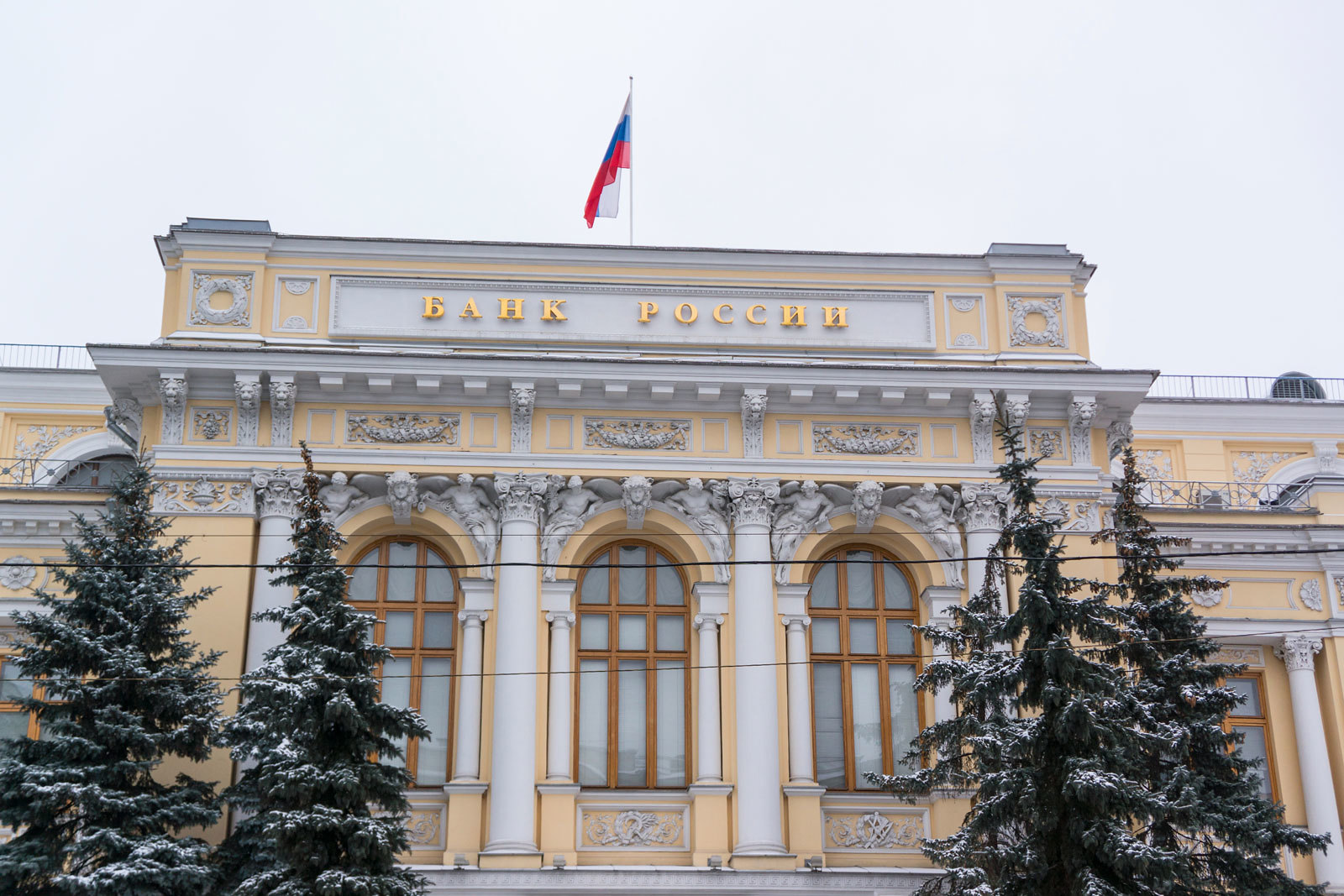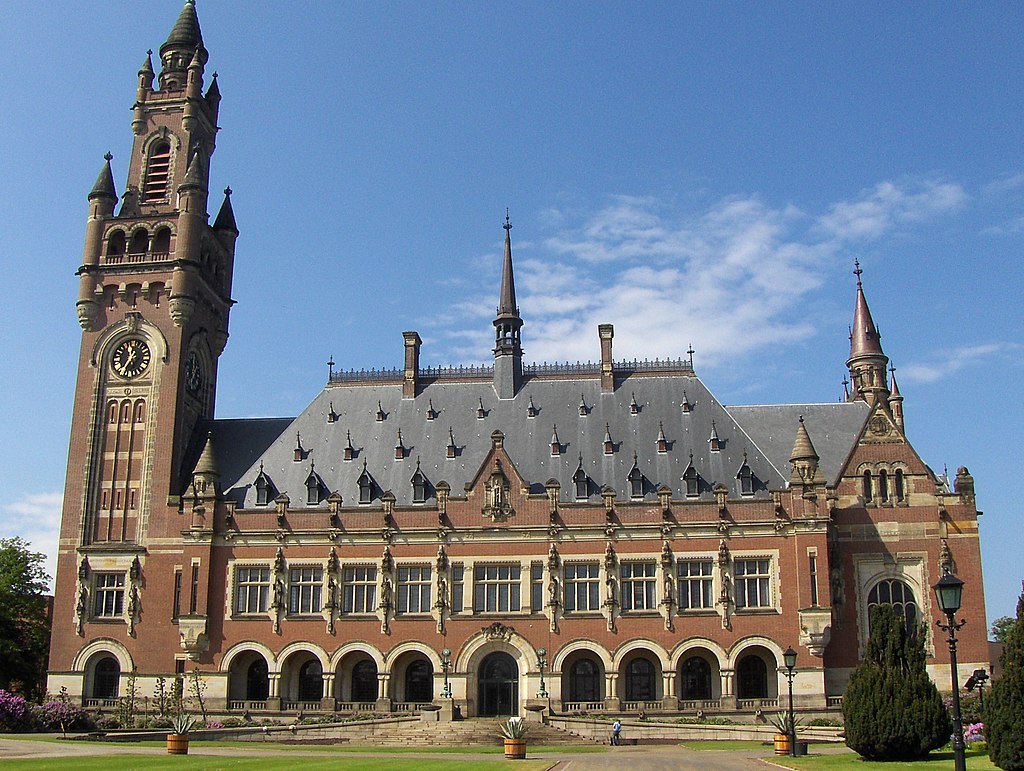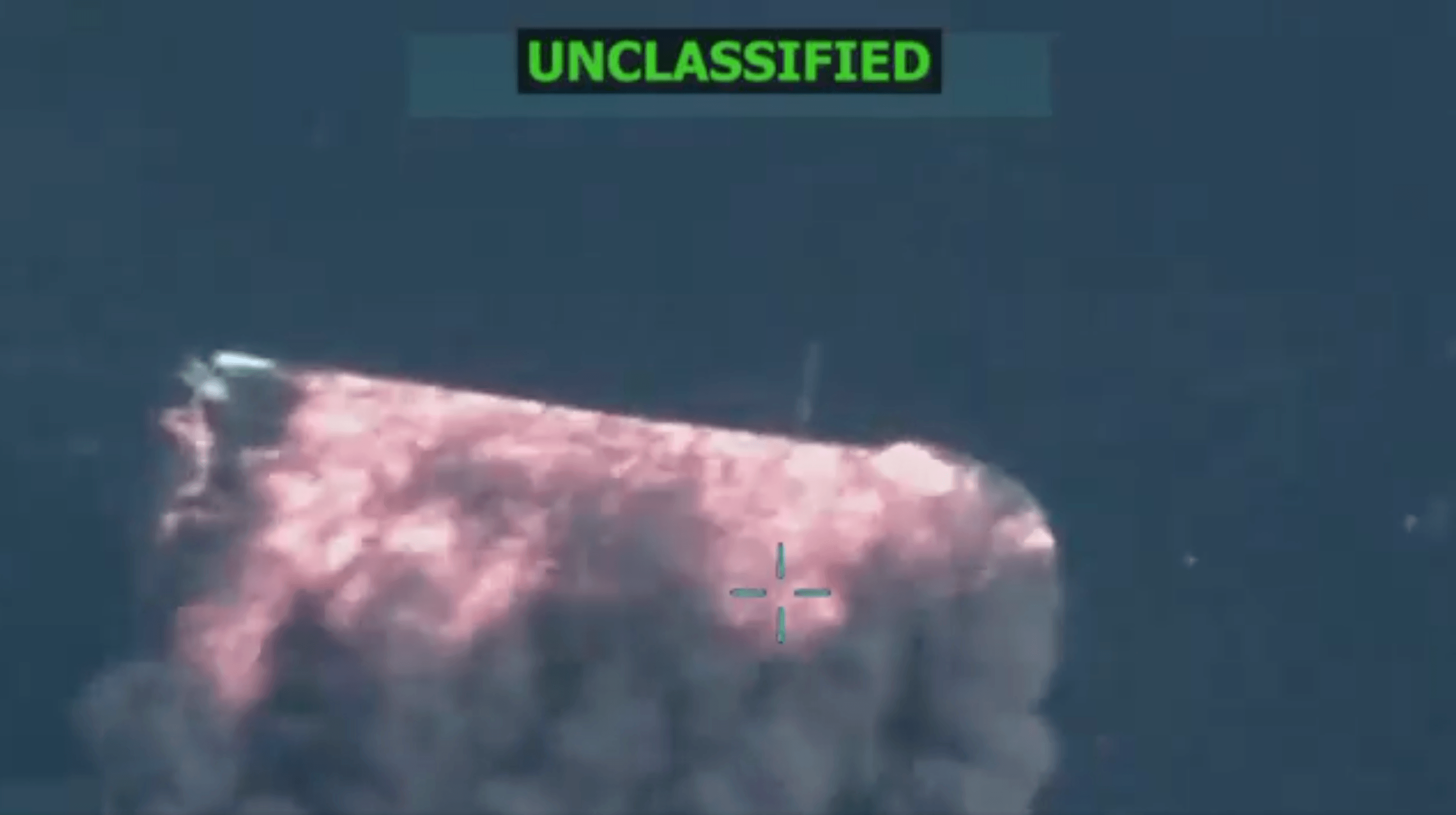What Sanctions Has the World Put on Russia?
The United States and its allies are imposing unprecedented sanctions on Russia in response to its invasion of Ukraine. But their effects may be felt far beyond Russia’s borders.

Published by The Lawfare Institute
in Cooperation With

Over the past week, the United States and its allies have responded to Russia’s invasion of Ukraine with some unprecedented actions of their own. But instead of engaging militarily, they have struck back at Russia’s economy.
The sanctions have escalated over the course of the week. What began on Feb. 21 as a purported set of targeted measures aimed at isolating the two breakaway Ukrainian regions of Donetsk and Luhansk has rapidly evolved into the most comprehensive set of multilateral economic sanctions ever applied to a major global economy. By implementing such dramatic steps so quickly, the Biden administration and its international partners no doubt hoped to impose costs that might force Russia to reconsider before its military campaign in Ukraine was too far along.
So far these efforts have been unsuccessful, even as the sanctions have ratcheted up in scope and severity. Russian President Vladimir Putin has shown no signs of reversing course. But as the consequences for the Russian people rapidly grow more severe, the hope from the U.S. and its allies appears to be that Putin’s calculus—or that of the people surrounding him—may yet change.
This post provides an overview of the sanctions measures that the United States and its allies have imposed on Russia since the outbreak of the Ukraine crisis. The post begins with an overview of U.S. sanctions measures. The second part discusses the steps that others in the international community have taken thus far. And the last part identifies what questions remain and where there may be further developments.
What Is the United States Doing?
While the sanctions against Russia are decidedly multilateral in nature, the United States has been both a driving force behind them and one of their most consistent participants.
Of course, U.S. sanctions on Russia are themselves nothing new. The United States has recently sanctioned a number of Russian individuals and institutions for objectionable conduct ranging from cybercrime to interference in the 2016 U.S. presidential elections. Some of these sanctions were mandated by Congress through laws like the Countering America’s Adversaries Through Sanctions Act of 2017. But most were created by the executive branch using the International Emergency Economic Powers Act (IEEPA), which authorizes the president to block transactions or otherwise regulate assets in which a foreign person has an interest when certain conditions are met.
One set of IEEPA-based measures installed by Executive Orders 13660, 13661, and 13662 responded to Russia’s prior 2014 invasion of Ukraine by targeting strategic sectors of Russia’s economy and thereby provided an early model for aspects of the most recent round of sanctions. But the most notable existing sanctions regime is the one created in April 2021 by Executive Order 14024, which authorizes IEEPA-based sanctions against Russian entities for all manner of malign international conduct, ranging from transnational corruption to threatening regional stability. This flexible April 2021 regime has in turn become the primary legal vehicle for most of the measures the United States is imposing on Russia in response to the invasion of Ukraine.
The first U.S. sanctions response to Russia’s recent actions in Ukraine came on Feb. 21, shortly after Putin formally recognized the breakaway Ukrainian territories of Donetsk and Luhansk. That same evening, President Biden issued Executive Order 14065, which uses IEEPA to sharply limit any trade and financial transactions involving the two breakaway territories. It also blocks any assets that persons who operate in those regions have within the United States or U.S. financial institutions and limits their ability to enter the United States.
The United States followed up with additional measures the next day. As Russian troops began to move into Ukraine, the United States imposed sanctions on a range of Russian financial institutions under Executive Order 14024. Specifically, on Feb. 22, the U.S. Department of the Treasury’s Office of Foreign Assets Control (OFAC) designated several state-owned financial institutions like Vnesheconombank (VEB) and Promsvyazbank Public Joint Stock Company (PSB) as well as their subsidiaries, effectively blocking their assets. OFAC followed up on Feb. 24 by similarly sanctioning an array of major private Russian financial institutions, including Russia’s second-largest financial institution, VTB Bank. Russia’s largest financial institution, Sberbank, and several of its subsidiaries were also prohibited from operating correspondent or payable-through accounts at U.S. financial institutions by Directive 2 under Executive Order 14024 but have not yet been subjected to general blocking sanctions, most likely to spare non-Russian users of its European and other worldwide subsidiaries.
U.S. sanctions have also targeted Russian elites believed to be close to Putin. On Feb. 22, OFAC designated an initial tranche of elites under Executive Order 14024, including Director of the Federal Security Service (FSB) Aleksander Bortnikov, Chairman and CEO of PSB Petr Fradkov—along with both men’s sons. OFAC designated additional elites as well as the senior executives of several major Russian financial institutions on Feb. 24 and—following the lead of the European Union—blocked Putin’s assets and those of several of his senior advisers, including Foreign Minister Sergey Lavrov, on Feb. 25. The next day, the United States and several allies announced the creation of a “transatlantic task force” that would identify Russian elites’ foreign assets and ensure that they are blocked or otherwise rendered unavailable, suggesting more designations were likely forthcoming. (The same announcement also indicated that those countries involved in the task force intended to crack down on the sale of “golden passports” providing Russian elites with alternate citizenships that allow them to evade certain sanctions measures.)
Nor has Russia been the only focus of such efforts. The United States has also targeted Belarus, whose territory Russia has used to launch its incursion into Ukraine and whose own forces recently joined the Russian siege on the Ukrainian capital of Kyiv. Specifically, the sanctions that OFAC announced on Feb. 24 included sanctions against several of Belarus’s major agencies and state-owned enterprises, their executives, along with senior Belorussian defense officials under Executive Order 14038, an August 2021 executive order that the Biden administration adopted to sanction Belarus for its anti-democratic activities.
Most of the above measures are conventional blocking sanctions, meaning that they use the authority provided by IEEPA to freeze the assets of the designated entities and block any related transactions within the United States or by U.S. persons, including U.S. financial institutions. But the United States has also adopted other measures that have more novel effects on the Russian economy.
First, the United States has taken steps to limit Russia’s ability to secure funds through sovereign debt by putting IEEPA-based limits on how U.S. persons can buy or trade them. Some such measures have been in place since April 2021, when OFAC implemented Directive 1 to Executive Order 14024, which restricts U.S. financial institutions (including the U.S.-based offices of foreign banks) from extending loans to or purchasing debt from certain major Russian institutions. On Feb. 22, however, OFAC issued a revised Directive 1A that further restricts U.S. financial institutions from engaging in the secondary market for bonds issued by Russia’s central bank, National Wealth Fund or Ministry of Finance. On Feb. 24, OFAC also adopted a new Directive 3 that puts similar restrictions on purchases of anything but short-term debt or equity issued by several other major Russian financial institutions and companies 30 days after they are designated. These institutions include not only Russia’s largest financial institution, Sberbank, and its largest privately owned financial institution, Alfa-Bank, but also its leading gas, maritime shipping, mining, oil, pipelines, railroad and telecommunications companies. Together, these sanctions put major constraints on these Russian institutions’ ability to receive loans and shrink the global market for—and thus the value of—any debt instruments they may offer or already have in circulation. This promises to make it substantially harder for the businesses to raise capital needed to operate or expand.
Second, the United States has imposed major export controls on certain sensitive exports to Russia using authorities provided by the Export Control Reform Act of 2018. Specifically, on Feb. 24, the U.S. Commerce Department’s Bureau of Industry and Security (BIS) announced that it was imposing export controls targeting Russia’s “defense, aerospace, and maritime sectors” with the goal of “cut[ting] off Russia’s access to vital technological inputs, atrophy[ing] key sectors of its industrial base, and undercut[ting] its strategic ambitions to exert influence on the world stage.” These controls, which went into effect on March 3 when relevant revisions to the Export Administration Regulations were published in the Federal Register, limit the export, reexport and transfer of both sensitive U.S.-origin items and sensitive foreign items that use U.S. licensed equipment, software and plans. BIS also added 49 Russian military institutions to the BIS’s Entity List among other related measures, thereby prohibiting any unlicensed transfers of a range of sensitive technology to them without a license.
Third, the White House announced as part of its Feb. 26 joint statement with international partners that it would work with allies to remove select Russian banks from the SWIFT interbank messaging system, a move that would inhibit those banks’ ability to engage in transactions with other international financial institutions. The United States, however, has not taken steps to implement this itself; instead, as SWIFT is regulated in Belgium, this ban is being implemented primarily by the European Union, as discussed below. Experts have questioned how significant the added effect of a SWIFT cut-off is likely to be, given that there are alternatives—including a SPFS system operated by Russia—and most of the banks being targeted are already the subject of blocking sanctions that prohibit any related transactions. But as the move was requested by Ukraine, it appears to have taken on symbolic significance as a sign of world and European support, which may explain broad statements of support by the United States and its partners.
Finally, and perhaps most importantly, the United States and a number of allies issued a joint statement on Feb. 26 announcing that they were taking dramatic steps to prevent Russia’s central bank from accessing its substantial foreign exchange reserves. Analysts had posited that these reserves, sometimes referred to as “Fortress Russia,” might allow Russia to withstand the effects of economic sanctions for an extended period. But on Feb. 28, OFAC issued a new Directive 4 under Executive Order 14024 that prohibits any transactions with the Central Bank of Russia, Russia’s Ministry of Finance, or its National Wealth Fund, including foreign exchange transactions, involving U.S. persons, U.S. institutions or the U.S. dollar.
This is by far the most dramatic step the United States and its allies have taken. The effective blocking of central bank assets is a severe measure that has previously been applied only to hostile foreign regimes, such as Iran, North Korea and Syria. Doing so prevents Russia from accessing most if not all of its substantial foreign exchange reserves, severely reducing its ability to stabilize its currency, compensate for its lack of access to global debt markets or otherwise take steps to stabilize its economy. Among other economic effects, this ensures that the broader sanctions imposed by the international community have their maximum effect.
Notably, OFAC has put in place a number of exceptions to these sanctions through a series of licenses. Most appear to be aimed at mitigating some of the impact of the sanctions on non-Russian entities and the broader global economy. Some permit certain routine financial interactions, like the servicing of debt obligations, while others permit a wind-down or divestment period for entities holding Russian debt or other investments that fall under the new sanctions. Others permit transactions relating to certain official functions, emergency services, or the export of agricultural commodities, medical devices, software updates, and other goods and services on which outsiders might disproportionately rely. Perhaps the most important exception applies to Russia’s substantial energy exports and permits transactions with many sanctioned entities, including Russia’s central bank, so long as they relate to nearly any aspect of the energy sector, ranging from coal and petroleum to nuclear fuel, through at least June 24. While these transactions will no doubt provide a lifeline to the Russian economy, they also prevent a supply shock to energy markets.
The unveiling of new sanctions has slowed to a halt in recent days. While President Biden announced that he was also cutting off U.S. airspace to Russian airlines in his State of the Union address on March 1, this move was several days behind those of European allies and was largely symbolic. Instead, U.S. authorities appear to be focused on fine-tuning the sanctions already put in place. Most notably, on March 2, OFAC issued updated guidance that seeks to clarify the scope of the imposed sanctions and close certain perceived loopholes, including efforts by the Russian central bank to use exporters as agents in order to evade sanctions restrictions. The same guidance also takes pains to underscore the fact that energy transactions are permitted and even articulates ways to structure transactions in order to avoid sanctions restrictions. In this sense, the Treasury Department appears to be just as concerned with economic actors overcomplying with the sanctions as undercomplying. This underscores the difficult line that the United States and its allies are attempting to walk in maximizing pressure on Russia without upsetting the broader world economy.
What Are Other Key Players Doing?
Of course, the United States can’t isolate Russia’s economy on its own. For this reason, the Biden administration has been careful to develop its sanctions policies in what the White House has described as “historically close coordination” with several other major economies. In his State of the Union address on March 1, President Biden noted that the United States had coordinated with “[27] members of the European Union, including France, Germany, Italy, as well as countries like the United Kingdom, Canada, Japan, [South] Korea, Australia, New Zealand, and many others—even Switzerland[.]” Several other governments opposed to Russia’s actions in Ukraine but not involved in the initial planning have also signed on to these sanctions measures, either in part or in whole.
But some countries have declined to participate in the effort. Among the G-20 countries representing the world’s largest economies, nine governments—Argentina, Brazil, China, India, Indonesia, Mexico, Saudi Arabia, South Africa and Turkey—have thus far declined to implement any sanctions measures against Russia. Neither have Russian client states, like Cuba, Nicaragua, Syria and Venezuela; other common strategic rivals of the United States and its allies, like Iran and North Korea; or states with strong cultural and economic ties to Russia, including Israel and most former Soviet states outside of Europe. Still, there are few outlets for Russia to alleviate the sanctions pressure. Only China seems like it might have the ability to aid Russia in evading the worst consequences of the current sanctions regimes by increasing their trade ties and allowing Russian banks to continue to use its SWIFT alternative, its Cross-Border Interbank Payment System (CIPS). But it is not yet clear whether China is willing and able to do so, despite the recent strengthening of bilateral ties between the two nations.
The implementation of sanctions has not necessarily proceeded in perfect lockstep. While the cooperating governments have coordinated their public statements and policy positions on sanctions matters, the actual implementation has proceeded at different paces and with different focuses, depending on the domestic legal authorities available and the implementing country’s economic and political relationship with Russia.
The European Union
The European Union has played perhaps the most active role in imposing sanctions on Russia after the United States. Like the United States, some EU sanctions against Russian individuals and entities date back to Russia’s purported 2014 annexation of Crimea. The additional measures adopted in the past few days, however, represent a major escalation in what the European Union has been willing to impose in the past.
The first move came on Feb. 23, the day before Russian military action began in Ukraine. That day the European Union announced a package of “targeted restrictive measures” on Russia including targeted sanctions on all members of the Russian state Duma who voted in favor of recognizing the breakaway territories of Donetsk and Luhansk. The package also imposed restrictive measures on 27 high-profile individuals and entities, including Russia’s defense minister and other high-profile members of the government. These restrictions encompass an EU asset freeze and travel restrictions. The package also placed restrictions on Russia’s use of European capital markets. Three Russian banks, Rossiya Bank, Promsvyazbank and VEB, were targeted for their financial ties to Crimea and will lose access to EU capital markets and business transactions with European companies. The European Union also restricted trade with the two breakaway republics in Donetsk and Luhansk.
On Feb. 25, the European Union announced additional sanctions in response to the Russian military invasion, which EU Foreign Affairs Representative Josep Borell called the EU’s “harshest sanctions ever.” This package directly targeted the assets of Putin and Lavrov, other members of the Russian Duma and government, and members of the Belorussian government who helped facilitate Russia’s troop movements through that country. These individualized sanctions include asset freezes and follow the parameters of the sanctions regime set by the EU in 2014 after the Russian annexation of Crimea.
The EU will also levy financial sanctions on Russian banks to “stop Putin from using his war chest.” And the EU announced on Feb. 26 that “selected Russian banks” would be removed from the SWIFT interbank messaging system.
EU legislation enacted on Feb. 28 targets Russia’s central bank, prohibiting any transaction with the bank or any representative thereof and freezes the reserves of the central bank held within the EU. These measures were imposed, according to a Feb. 26 statement, to “prevent the Russian Central Bank from deploying its international reserves in ways that undermine the impact of [the EU’s] sanctions.” These measures, however, do not freeze the assets of Russia’s three largest banks: Sberbank, VTB, and Gazprombank.
The Feb. 25 sanctions also restrict key Russian industries, such as technology, transport and energy. The EU will prohibit export of materials and technologies used in oil refining, as well as supplies of parts and machines to Russian airlines (an EU factsheet notes that three-quarters of Russian commercial planes were manufactured in the U.S., EU or Canada). The EU has restricted exports of dual-use technological goods that “might contribute to Russia’s … defence and security sector,” including semiconductors. The package also imposed EU visa restrictions on certain categories of individuals, including Russian representatives and diplomats.
The Feb. 27 ramp-up also targeted Belorussian President Alexander Lukashenko’s regime. European Commission President Ursula Von der Leyen announced new restrictive measures on significant export sectors of the Belorussian economy, including an EU export restriction on the same category of dual-use restricted for Russian export.
EU member states, including France, Germany, and Italy, are obligated to implement EU sanctions. But some member states have also taken individual measures to amplify the economic impact on Russia. Most notably, on Feb. 22, Germany halted the controversial Nord Stream 2 pipeline construction project that would have connected it to Russian natural gas supplies. While this did not immediately impact German energy imports from Russia, it signaled a possible long-term move away from reliance on Russian energy imports.
Australia
On Feb. 23, Prime Minister Scott Morrison announced that Australia would apply an array of sanctions in response to Russia’s actions in Ukraine, in coordination with the United States and United Kingdom. These measures included targeted financial sanctions on eight members of Russia’s Security Council; financial sanctions on an array of Russian banks, including VEB; and an expansion of existing sanctions on Crimea and Sevastopol to the Donetsk and Luhansk regions.
In a public speech on Feb. 25, Morrison announced additional sanctions on Russia targeting “oligarchs whose economic weight is of strategic significance to Moscow” and more than 300 members of Russia’s parliament. It also implemented new criteria for further sanctions relating to Russia, allowing them to be levied against organizations and entities of “strategic and economic significance,” senior officials and their family members.
The Australian government added to these measures in another statement on Feb. 28, where it noted its intent to coordinate with the United States and allied countries in removing Russian banks from the SWIFT system, imposing restrictions on Russia’s central bank, targeting golden passports, and forming a transatlantic sanctions task force. In addition, the statement notes that Australia sanctioned 13 Belarusian individuals and entities, including Viktor Khrenin, Belarus’s minister of defense, for aiding and abetting Putin’s aggressions by allowing Russia to launch attacks against Ukraine from Belarus territory.
Canada
On Feb. 22, Prime Minister Justin Trudeau indicated that Canada would impose sanctions on Russia for recognizing the Ukraine separatist regions of Donetsk and Luhansk as independent regions. Specifically, his government sanctioned Russian lawmakers who had voted to authorize Russia’s recognition and banned Canadians from conducting financial dealings within either region. Canadians are also be banned from engaging in purchases of Russian foreign debt or financial dealings with two state-backed Russian banks.
On Feb. 24, Canadian officials announced the implementation of both these sanctions and additional sanctions measures. The amended sanctions regulations implemented sanctions against several members of Russia’s wealthy elite and their families, more than two dozen key Russian financial institutions, and the Russian paramilitary group Wagner, among others. The Canadian government also canceled all existing export permits and is refusing to issue any new permits for Russian entities.
On Feb. 25, Trudeau announced more new sanctions aimed at members of the Russian Security Council, including Putin and Lavrov, whom Trudeau called the “architects of this barbaric war.” He also announced sanctions against Belarusian leaders, including President Lukashenko, for their support of Putin’s war in Ukraine. The sanctions against Belarus are in addition to the sanctions previously levied against Belarus for the country’s human rights violations.
On Feb. 26, Canada issued the joint statement with the United States and other partners announcing their intent to remove select Russian banks from SWIFT, take steps to prevent Russia’s central bank from accessing its foreign exchange reserves, establish a transatlantic task force for targeting Russian oligarchs, and prevent the use of golden passports. These measures and those announced on Feb. 25 were implemented through new sanctions regulations on Feb. 28.
The Ministry of Foreign Affairs announced new measures on March 2, including restrictions on 10 individuals from Rosneft and Gazprom. The Ministry of Foreign Affairs statement notes that “Canada is taking these actions alongside its international partners and allies and in solidarity with the government and people of Ukraine.”
Japan
On Feb. 23, Japanese officials indicated that Japan would be joining international sanctions in response to Russia’s recognition of Donetsk and Luhansk and invasion of Ukraine. The sanctions package announced on Feb. 24 froze assets related to Donetsk and Luhansk, prohibited trade relations with the two breakaway territories, put limits on trading Russian sovereign debt in the primary and secondary markets, and imposed some additional limitations on Russian banks’ ability to sell securities.
Japan followed up on Feb. 25 with additional sanctions that froze the assets of certain designated individuals relating to Russia as well as those of three Russian banks. It also imposed export controls on semiconductors and other technology, prohibiting sales to entities associated with the Russian military.
On Feb. 27, Japan announced that it would join the global SWIFT ban on Russian banks and impose additional restrictions on Russia’s central bank and other Russian financial institutions aimed at limiting their access to Russia’s foreign exchange reserves. The new package of sanctions also included measures targeting Putin and Lavrov directly and limits sensitive exports to a number of additional Russian agencies. Japan has since continued to expand these sanctions to new Russian financial institutions and individuals, in line with EU and U.S. sanctions.
New Zealand
The government of New Zealand has been outspoken in its opposition to Russian aggression in Ukraine. But it has not yet joined sanctions efforts as it does not have a domestic law that allows the government to impose sanctions that have not been put in place by the U.N. Security Council. Some legislators, however, have reportedly begun to explore the possibility of enacting such a law.
On Feb. 25, New Zealand did implement export controls restricting the export of any goods to Russia that are intended for direct or indirect use by the Russian military or other security forces, or for the production or development of military goods. It has also installed a travel ban on certain individuals associated with Russia’s offensive in Ukraine.
South Korea
President Moon Jae-in announced that South Korea would join international sanctions on Russia on Feb. 24, a position reiterated by the country’s Ministry of Foreign Affairs in a press release the next day. South Korean officials, however, later suggested that they would focus on complying with European and U.S. sanctions and export controls as opposed to implementing any of their own.
On Feb. 28, the Ministry of Foreign Affairs issued another press release indicating that South Korea would be reviewing its export control policies to further block the export of strategic items to Russia, and was working on restrictions on various nonstrategic items covered by U.S. export control measures. In addition, South Korea indicated it would participate in the exclusion of Russian banks from SWIFT and help to curb global energy shortages by releasing some of its own strategic petroleum reserves and diverting some liquefied natural gas shipments to Europe.
On March 1, the Ministry of Finance indicated that it would be banning financial transactions with seven major Russian banks and their affiliates on a timeline that matches U.S. sanctions, with exceptions for agriculture, coronavirus medication and energy. It also “strongly recommended” that South Koreans stop investments in Russian government bonds.
Switzerland
On Feb. 28, Federal President Ignazio Cassis said that Switzerland would align its own sanctions with those of the European Union. According to a press release from the Swiss Federal Council, the Swiss government would “adopt the packages of sanctions imposed by the EU on 23 and 25 February,” as discussed above. That includes freezing the assets of those listed in the EU’s sanctions. Swiss authorities also indicated that they would mirror the EU’s personal sanctions on Putin, Lavrov and Prime Minister Mikhail Mishustin.
On March 3, Switzerland’s Federal Pension Fund PUBLICA announced that it would no longer buy Russian securities and intended to divest any of its current holdings.
On March 4, Swiss officials announced yet another sanctions package intended to mirror measures imposed by the EU. This package included limits on the export of sensitive and dual-use technologies, trade in goods related to various strategic sectors of Russia’s economy, and financial transactions with Russia’s central bank and various other Russian financial institutions. It also adopted sanctions against persons sanctioned by the EU for having close ties to Putin. The Swiss government noted that its restrictions on sensitive and dual-use exports would be subject to “the principle of equal treatment” consistent with Switzerland’s general policy of neutrality, suggesting that similar restrictions may apply to Ukraine as well.
Taiwan
On Feb. 23, the Ministry of Foreign Affairs issued a statement condemning Russia’s actions and expressed a willingness to work with the international community in restoring peace and stability. On Feb. 25, the ministry announced that Taiwan intended to join the international sanctions on Russia in response to its invasion of Ukraine. Among other measures, this included export restrictions on semiconductors that Russia is highly reliant on for the manufacture of advanced technology.
The United Kingdom
The United Kingdom has also played a lead role in sanctioning Russia. The U.K.’s sanctions against Russia fall under its “Russia sanctions regime,” which falls under the “Russia (Sanctions) (EU Exit) Regulations 2019.” That law came into effect on Dec. 31, 2020, and is “aimed at encouraging Russia to cease actions destabili[z]ing Ukraine or undermining or threatening the territorial integrity, sovereignty or independence of Ukraine.”
On Feb. 22, the U.K. announced targeted economic sanctions on Russia. In a speech in the House of Commons, Prime Minister Boris Johnson announced that the U.K. would target Rossiya, IS Bank, General Bank Promsvyazbank and the Black Sea Bank. He also announced that three “very high networth individuals,” Gennady Timchenko, Boris Rotenberg and Igor Rotenberg, will have their assets in the U.K. frozen, are banned from traveling to the U.K., and cannot do business with any entities in the U.K.
On Feb. 24, Johnson said that the United Kingdom will impose sanctions to “hobble” Russia’s economy. Johnson has announced several unilateral measures. This list of sanctions-related actions includes freezing assets of major Russian banks; introducing legislation that will forbid Russian companies to raise money on markets in the United Kingdom; sanctioning more than 100 “companies and oligarchs at the heart of Putin’s regime”; forbidding Aeroflot, the Russian airline, from landing in the U.K.; suspending export licenses; banning technology exports including equipment for oil and gas extraction, a move that the Guardian notes “ is being done in concert with the U.S.”; limiting deposits of Russian nationals in U.K. bank accounts; lobbying countries to deny Russia access to the SWIFT system; applying sanctions to Belarus; and eventually drafting a U.K. economic crime bill “on unexplained wealth orders.”
The entities that will be sanctioned include VTB, one of Russia's largest banks; Rostec, the largest defense company in Russia; Tactile Missile Corporation, a supplier of air and sea missiles; Putin’s former son-in-law Kirill Shamalov; and Uralvagonzavod, a tank manufacturer. The U.K. government also announced that sanctions will apply to 571 members of the Duma and Federation Council. In his speech outlining the sanctions to the House of Commons, Johnson said, “We will continue on a remorseless mission to squeeze Russia from the global economy piece by piece, day by day and week by week.”
On March 1, the U.K.’s foreign secretary announced additional measures, including banning Russian ships from the U.K.’s ports; forbidding Sberbank from clearing payments in the U.K.’s financial system; freezing the assets of the Russian Direct Investment Fund and its chief executive, Kirill Dmitriev; along with measures against the Russian National Wealth Fund and the Russian central bank. With this latest round, the announcement claims, “the majority of Russia’s financial system is now covered by UK sanctions.”
What Comes Next?
What the full impact of these sanctions will be is far from clear. Russian officials have acknowledged that their economy is already taking “serious blows,” even though many of the sanctions measures are still in the process of being implemented. The value of Russia’s currency, the ruble, has reached historic lows and is continuing to fall. Russian banks are unable to meet customers’ demands for withdrawals and have dramatically increased interest rates. Meanwhile, most of the tools that the Russian government might use to mitigate these economic consequences have been taken away by the broad sanctions on its central bank and other key financial institutions, forcing officials to resort to imposing currency controls on Russian citizens and restricting foreign investors’ ability to exit.
A growing number of major transnational corporations, ranging from Maersk shipping lines to BP, are substantially reducing their economic relationships with Russia and Russian corporations, to an extent well beyond that required by sanctions. Even Russian oligarchs who have not yet been sanctioned are reportedly unloading their overseas holdings for fear that they will be next. Economists have estimated that the Russian economy could shrink a full 7 percent by the end of 2022, introducing the greatest recession in recent memory and severely undermining the quality of life for nearly every Russian citizen. Meanwhile, export controls and debt limitations promise to seriously hinder strategic sectors of Russia’s economy. These moves could slow development in these sectors in a way that could endure well past the end of any sanctions.
Nor are the consequences likely to be limited to Russia. While the Biden administration has suggested that these sanctions are “designed … to maximize the long-term impact on Russia and to minimize the impact on the United States and [its] [a]llies[,]” some ripple effects into the broader global economy are unavoidable. The United States and its allies have sought to hedge against these consequences by leaving the door open for Russia to continue to engage global energy markets and by releasing some of their own strategic oil reserves to avoid spikes in energy prices—especially as any dramatic increase in energy prices may actually work to Russia’s benefit. But energy prices have begun to escalate and non-Russians with substantial investments in and economic ties to Russia, including those owning Russian debt, are still likely to suffer substantial losses.
For the moment, the United States and its allies appear to have paused the rollout of additional sanctions measures, both in order to gauge the consequences of the current measures that are already being put in place and to give some time for Russians to begin to feel the economic pressure the measures are designed to impose. But more sanctions may yet be forthcoming. Some members of the U.S. Congress have reportedly expressed an interest in imposing even further sanctions by statute, including on Russia’s energy exports, despite reservations within the Biden administration. On March 3, Sen. Robert Menendez, chairman of the Senate Foreign Relations Committee, sent a letter to the State and Treasury departments urging them to take additional sanctions-related measures, including limitations on the ability of Russians to make deposits into U.S. financial institutions and purchases of U.S. securities, additional sanctions on Belarus, and the establishment of an international task force on sanctions coordination. Whether Congress will mandate such measures through legislation or persuade the Biden administration to pursue them remains to be seen.
Some experts, however, have argued that the focus may need to shift from implementing new sanctions to planning for how to roll back those already in place. Given that the sanctions were originally intended to motivate a change in Russia’s political behavior, the United States and its allies need to figure out what sanctions they are willing to rescind if Russia does prove willing to enter negotiations or otherwise take steps toward ending its operations in Ukraine. Some calibration may also be needed if the sanctions have unforeseen or unintentionally severe consequences for the general population of Russia, such as shortages in food and medicine or other potential humanitarian crises—or if the consequences of Russia’s impending economic collapse begin to ripple more broadly throughout the global economy. In other words, to send the strongest possible message to Putin, the Biden administration and its allies chose to jump straight to the top of the escalation ladder. Now they may need to spend some time thinking about the best way to climb back down.
Doing so, however, may ultimately be easier said than done. While some of the consequences of these economic sanctions are likely to go away when they are lifted, others may not. The stigma that has suddenly surrounded economic entanglement with Russia may well linger among investors and corporations with ties to the United States and other sanctioning economies. After all, even if sanctions are lifted, there is always the risk they will be reimposed over some other dispute down the line. Nor is Russia likely to be enthusiastic about re-creating the economic ties that the United States and its allies are now using against it. This may lead Russia to turn even further inward and to further strengthen ties with China and other countries that are unwilling to cooperate with U.S.-led sanctions efforts. Hence, even if the United States and its allies are successful in bringing peace to Ukraine, the steps they have had to take to do so may deepen cleavages in the global system of economic interdependence that has helped to promote stability for much of the past century.
Note: This piece draws from a conversation that one of the co-authors, Scott R. Anderson, recently had with sanctions experts Julia Friedlander of the Atlantic Council and Rachel Ziemba of the Center for a New American Security for the Lawfare Podcast. You can listen to that discussion here.









